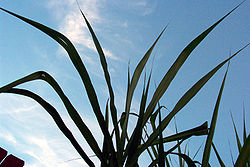Sustainable biofuel
| Renewable energy |
|---|
|
Biofuel |
Biofuels, in the form of liquid fuels derived from plant materials, are entering the market, driven by factors such as oil price spikes and the need for increased energy security. However, many of the biofuels that are currently being supplied have been criticised for their adverse impacts on the natural environment, food security, and land use.[1][2]
The challenge is to support biofuel development, including the development of new cellulosic technologies, with responsible policies and economic instruments to help ensure that biofuel commercialization is sustainable. Responsible commercialization of biofuels represents an opportunity to enhance sustainable economic prospects in Africa, Latin America and Asia.[1][3][2]
Biofuels offer the prospect of increased market competition and oil price moderation. A healthy supply of alternative energy sources will help to combat gasoline price spikes and reduce dependency on fossil fuels, especially in the transport sector.[2] Using transportation fuels more efficiently is also an integral part of a sustainable transport strategy.
Contents |
Biofuel options
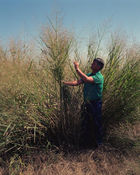
Biofuel development and use is a complex issue because there are many biofuel options which are available. Biofuels, such as ethanol and biodiesel, are currently produced from the products of conventional food crops such as the starch, sugar and oil feedstocks from crops that include wheat, maize, sugar cane, palm oil and oilseed rape. Any major switch to biofuels from such crops would create a direct competition with their use for food and animal feed, and in some parts of the world we are already seeing the economic consequences of such competition.[4]
Second generation biofuels are now being produced from a much broader range of feedstocks including the cellulose in dedicated energy crops (perennial grasses such as switchgrass and Miscanthus giganteus), forestry materials, the co-products from food production, and domestic vegetable waste[5]. Advances in the conversion processes[6] will improve the sustainability of biofuels, through better efficiencies and reduced environmental impact of producing biofuels, from both existing food crops and from cellulosic sources.[7]
Lord Ron Oxburgh suggests that responsible production of biofuels has several trade-offs:
Produced responsibly they are a sustainable energy source that need not divert any land from growing food nor damage the environment; they can also help solve the problems of the waste generated by Western society; and they can create jobs for the poor where previously were none. Produced irresponsibly, they at best offer no climate benefit and, at worst, have detrimental social and environmental consequences. In other words, biofuels are pretty much like any other product.[8]
According to the Rocky Mountain Institute, sound biofuel production practices would not hamper food and fibre production, nor cause water or environmental problems, and would enhance soil fertility.[9] The selection of land on which to grow the feedstocks is a critical component of the ability of biofuels to deliver sustainable solutions. A key consideration is the minimization of biofuel competition for prime cropland.[4][10]
Plants used as sustainable biofuel
Sugarcane in Brazil
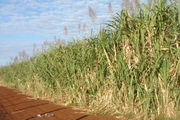

Brazil’s production of ethanol fuel from sugarcane dates back to the 1970s, as a governmental response to the 1973 oil crisis. Brazil is considered the biofuel industry leader and the world's first sustainable biofuels economy.[11][12][13][14] On 2010 the U.S. Environmental Protection Agency designated Brazilian sugarcane ethanol as an advanced biofuel due to EPA's estimated 61% reduction of total life cycle greenhouse gas emissions, including direct indirect land use change emissions.[15][16]
Brazil sugarcane ethanol fuel program success and sustainability is based on the most efficient agricultural technology for sugarcane cultivation in the world,[17] uses modern equipment and cheap sugar cane as feedstock, the residual cane-waste (bagasse) is used to process heat and power, which results in a very competitive price and also in a high energy balance (output energy/input energy), which varies from 8.3 for average conditions to 10.2 for best practice production.[13][18]
A report commissioned by the United Nations, based on a detailed review of published research up to mid-2009 as well as the input of independent experts world-wide, found that ethanol from sugar cane as produced in Brazil "in some circumstances does better than just “zero emission”. If grown and processed correctly, it has negative emission, pulling CO2 out of the atmosphere, rather than adding it. In contrast, the report found that U.S. use of maize for biofuel is less efficient, as sugarcane can lead to emissions reductions of between 70% and well over 100% when substituted for gasoline.[19][20] Several other studies have shown that sugarcane based ethanol reduces greenhouse gases by 86 to 90% if there is no significant land use change.[18][21][22]
In another study commissioned by the Dutch government in 2006 to evaluate the sustainability of Brazilian bioethanol concluded that there is sufficient water to supply all foreseeable long-term water requirements for sugarcane and ethanol production.[23] This evaluation also found that consumption of agrochemicals for sugar cane production is lower than in citric, corn, coffee and soybean cropping. The study found that development of resistant sugar cane varieties is a crucial aspect of disease and pest control and is one of the primary objectives of Brazil’s cane genetic improvement programs. Disease control is one of the main reasons for the replacement of a commercial variety of sugar cane.[23]
Another concern is the fact that sugarcane fields are traditionally burned just before harvest to avoid harm to the workers, by removing the sharp leaves and killing snakes and other harmful animals, and also to fertilize the fields with ash.[24] Mechanization will reduce pollution from burning fields and has higher productivity than people, and due to mechanization the number of temporary workers in the sugarcane plantations has already declined.[23] By the 2008 harvest season, around 47% of the cane was collected with harvesting machines.[24][25]
Regarding the negative impacts of the potential direct and indirect effect of land use changes on carbon emissions,[26][27] the study commissioned by the Dutch government concluded that "it is very difficult to determine the indirect effects of further land use for sugar cane production (i.e. sugar cane replacing another crop like soy or citrus crops, which in turn causes additional soy plantations replacing pastures, which in turn may cause deforestation), and also not logical to attribute all these soil carbon losses to sugar cane".[23] The Brazilian agency Embrapa estimates that there is enough agricultural land available to increase at least 30 times the existing sugarcane plantation without endangering sensible ecosystems or taking land destined for food crops.[28] Most future growth is expected to take place on abandoned pasture lands, as it has been the historical trend in São Paulo state.[13][29][28][30] Also, productivity is expected to improve even further based on current biotechnology research, genetic improvement, and better agronomic practices, thus contributing to reduce land demand for future sugarcane cultures.[28][30]
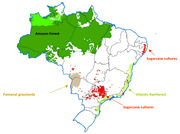
Another concern is the risk of clearing rain forests and other environmentally valuable land for sugarcane production, such as the Amazonia, the Pantanal or the Cerrado.[26][31][27][32][33] Embrapa has rebutted this concern explaining that 99.7% of sugarcane plantations are located at least 2,000 km from the Amazonia, and expansion during the last 25 years took place in the Center-South region, also far away from the Amazonia, the Pantanal or the Atlantic forest. In São Paulo state growth took place in abandoned pasture lands.[28][30] The impact assessment commissioned by the Dutch government supported this argument.[23]
In order to guarantee a sustainable development of ethanol production, in September 2009 the government issued by decree a countrywide agroecological land use zoning to restrict sugarcane growth in or near environmentally sensitive areas.[34][35][36] According to the new criteria, 92.5% of the Brazilian territory is not suitable for sugarcane plantation. The government considers that the suitable areas are more than enough to meet the future demand for ethanol and sugar in the domestic and international markets foreseen for the next decades.[35][36]
Regarding the food vs fuel issue, a World Bank research report published on July 2008[37] found that "Brazil's sugar-based ethanol did not push food prices appreciably higher".[38][39] This research paper also concluded that Brazil's sugar cane based ethanol has not raised sugar prices significantly.[37] An economic assessment report also published in July 2008 by the OECD[40] agrees with the World Bank report regarding the negative effects of subsidies and trade restrictions, but found that the impact of biofuels on food prices are much smaller.[41] A study by the Brazilian research unit of the Fundação Getúlio Vargas regarding the effects of biofuels on grain prices[42] concluded that the major driver behind the 2007-2008 rise in food prices was speculative activity on futures markets under conditions of increased demand in a market with low grain stocks. The study also concluded that there is no correlation between Brazilian sugarcane cultivated area and average grain prices, as on the contrary, the spread of sugarcane was accompanied by rapid growth of grain crops in the country.[42]
Jatropha in India and Africa
_in_Hyderabad,_AP_W_IMG_9219.jpg)
Crops like Jatropha, used for biodiesel, can thrive on marginal agricultural land where many trees and crops won't grow, or would produce only slow growth yields.[43][44] Jatropha cultivation provides benefits for local communities:
Cultivation and fruit picking by hand is labour-intensive and needs around one person per hectare. In parts of rural India and Africa this provides much-needed jobs - about 200,000 people worldwide now find employment through jatropha. Moreover, villagers often find that they can grow other crops in the shade of the trees. Their communities will avoid importing expensive diesel and there will be some for export too.[43]
Jatropha in Cambodia
Cambodia has no proven fossil fuel reserves, and is almost completely dependent on imported diesel fuel for electricity production. Consequently Cambodians face an insecure supply and pay some of the highest energy prices in the world. The impacts of this are widespread and may hinder economic development.[45]
Biofuels may provide a substitute for diesel fuel that can be manufactured locally for a lower price, independent of the international oil price. The local production and use of biofuel also offers other benefits such as improved energy security, rural development opportunities and environmental benefits. The Jatropha curcas species appears to be a particularly suitable source of biofuel as it already grows commonly in Cambodia. Local sustainable production of biofuel in Cambodia, based on the Jatropha or other sources, offers good potential benefits for the investors, the economy, rural communities and the environment.[45]
Pongamia Pinnata in Australia and India
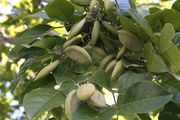
Pongamia pinnata is a legume native to Australia, India, Florida (USA) and most tropical regions, and is now being invested in as an alternative to Jatropha for areas such as Northern Australia, where Jatropha is classed as a noxious weed.[46] Commonly known as simply 'Pongamia', this tree is currently being commercialised in Australia by Pacific Renewable Energy, for use as a Diesel replacement for running in modified Diesel engines or for conversion to Biodiesel using 1st or 2nd Generation Biodiesel techniques, for running in unmodified Diesel engines.[47]
There are currently a number of Pongamia plantations in India and new trial plantations in Australia in Areas as diverse as Coastal South East Queensland, to Roma, Queensland.[48][49][50]
Sweet sorghum in India
Sweet sorghum overcomes many of the shortcomings of other biofuel crops. With sweet sorghum, only the stalks are used for biofuel production, while the grain is saved for food or livestock feed. It is not in high demand in the global food market, and thus has little impact on food prices and food security. Sweet sorghum is grown on already-farmed drylands that are low in carbon storage capacity, so concerns about the clearing of rainforest do not apply. Sweet sorghum is easier and cheaper to grow than other biofuel crops in India and does not require irrigation, an important consideration in dry areas.[51] Some of the Indian sweet sorghum varieties are now grown in Uganda for ethanol production.[52]
International collaboration on sustainable biofuels
Roundtable on Sustainable Biofuels
Public attitudes and the actions of stakeholders can play a crucial role in realising the potential of biofuels. Informed discussion and dialogue, based both on the scientific case and an understanding of public and stakeholder views, is important.[53]
The Roundtable on Sustainable Biofuels is an international initiative which brings together farmers, companies, governments, non-governmental organizations, and scientists who are interested in the sustainability of biofuels production and distribution. During 2008, the Roundtable developed a series of principles and criteria for sustainable biofuels production through meetings, teleconferences, and online discussions.[54]
The Roundtable for Sustainable Biofuels released “Version Zero” of its proposed standards for sustainable biofuels on August 13, 2008. This includes a dozen principles, each with several criteria developing the principle further. The 12 principles are:[55]
- Biofuel production shall follow international treaties and national laws regarding such things as air quality, water resources, agricultural practices, labor conditions, and more.
- Biofuels projects shall be designed and operated in participatory processes that involve all relevant stakeholders in planning and monitoring.
- Biofuels shall significantly reduce greenhouse gas emissions as compared to fossil fuels. The principle seeks to establish a standard methodology for comparing greenhouse gases (GHG) benefits.
- Biofuel production shall not violate human rights or labor rights, and shall ensure decent work and the well-being of workers.
- Biofuel production shall contribute to the social and economic development of local, rural and indigenous peoples and communities.
- Biofuel production shall not impair food security.
- Biofuel production shall avoid negative impacts on biodiversity, ecosystems and areas of high conservation value.
- Biofuel production shall promote practices that improve soil health and minimize degradation.
- Surface and groundwater use will be optimized and contamination or depletion of water resources minimized.
- Air pollution shall be minimized along the supply chain.
- Biofuels shall be produced in the most cost-effective way, with a commitment to improve production efficiency and social and environmental performance in all stages of the biofuel value chain.
- Biofuel production shall not violate land rights.
Sustainable Biofuels Consensus
The Sustainable Biofuels Consensus is an international initiative which calls upon governments, the private sector, and other stakeholders to take concerted, collaborative and coordinated action to ensure the sustainable trade, use and production of biofuels. In this way biofuels may play a key role in the transformation of the energy sector, climate stabilization and resulting worldwide renaissance of rural areas, all of which are urgently needed.[56]
The Sustainable Biofuels Consensus envisions a landscape that provides food, fodder, fiber, and energy, which offers opportunities for rural development; that diversifies energy supply, restores ecosystems, protects biodiversity, and sequesters carbon.[56]
Sustainability standards
Several countries and regions have introduced policies or adopted standards to promote sustainable biofuels production and use, most prominently the European Union and the United States. The 2009 EU Renewable Energy Directive, which requires 10 percent of transportation energy from renewable energy by 2020, is the most comprehensive mandatory sustainability standard in place as of 2010. The Directive requires that the lifecycle greenhouse gas emissions of biofuels consumed be at least 50 percent less than the equivalent emissions from gasoline or diesel by 2017 (and 35 percent less starting in 2011). Also, the feedstocks for biofuels "should not be harvested from lands with high biodiversity value, from carbon-rich or forested land, or from wetlands".[57]
As with the EU, the U.S. Renewable Fuel Standard (RFS) and the California Low Carbon Fuel Standard (LCFS) both require specific levels of lifecycle greenhouse gas reductions compared to equivalent fossil fuel consumption. The RFS requires that at least half of the biofuels production mandated by 2022 should reduce lifecycle emissions by 50 percent. The LCFS is a performance standard that calls for a minimum of 10 percent emissions reduction per unit of transport energy by 2020. Both the U.S. and California standards currently address only greenhouse gas emissions, but California plans to "expand its policy to address other sustainability issues associated with liquid biofuels in the future".[57]
In 2009, Brazil also adopted new sustainability policies for sugarcane ethanol, including "zoning regulation of sugarcane expansion and social protocols".[57]
Oil price moderation
Biofuels offer the prospect of real market competition and oil price moderation. According to the Wall Street Journal, crude oil would be trading 15 per cent higher and gasoline would be as much as 25 per cent more expensive, if it were not for biofuels. A healthy supply of alternative energy sources will help to combat gasoline price spikes.[2][44]
Sustainable transport
Biofuels have a limited ability to replace fossil fuels and should not be regarded as a ‘silver bullet’ to deal with transport emissions. Biofuels on their own cannot deliver a sustainable transport system and so must be developed as part of an integrated approach, which promotes other renewable energy options and energy efficiency, as well as moderating the overall demand and need for transport. The development of hybrid and fuel cell vehicles, public transport, and better urban and rural planning all need to be considered.[58]
In December 2008 an Air New Zealand jet completed the world's first commercial aviation test flight partially using jatropha-based fuel. More than a dozen performance tests were undertaken in the two hour test flight which departed from Auckland International Airport. A biofuel blend of 50:50 jatropha and Jet A1 fuel was used to power one of the Boeing 747-400's Rolls-Royce RB211 engines.[59][60]
Air New Zealand set several criteria for its jatropha, requiring that "the land it came from was neither forest nor virgin grassland in the previous 20 years, that the soil and climate it came from is not suitable for the majority of food crops and that the farms are rain fed and not mechanically irrigated". The company has also set general sustainability criteria, saying that such biofuels must not compete with food resources, that they must be as good as traditional jet fuels, and that they should be cost competitive with existing fuels.[61]
In January 2009, Continental Airlines used a sustainable biofuel to power a commercial aircraft for the first time in North America. This demonstration flight marks the first sustainable biofuel demonstration flight by a commercial carrier using a twin-engined aircraft, a Boeing 737-800, powered by CFM International CFM56-7B engines. The biofuel blend included components derived from algae and jatropha plants. The algae oil was provided by Sapphire Energy, and the jatropha oil by Terasol Energy.[62]
References
- ↑ 1.0 1.1 The Royal Society (January 2008). Sustainable biofuels: prospects and challenges, ISBN 978 0 85403 662 2, p. 61.
- ↑ 2.0 2.1 2.2 2.3 Gordon Quaiattini. Biofuels are part of the solution Canada.com, April 25, 2008. Retrieved December 23, 2009.
- ↑ EPFL Energy Center (c2007). Roundtable on Sustainable Biofuels Retrieved December 23, 2009.
- ↑ 4.0 4.1 The Royal Society (2008). p. 2.
- ↑ Oliver R. Inderwildi, David A. King (2009). "Quo Vadis Biofuels". Energy & Environmental Science 2: 343. doi:10.1039/b822951c.
- ↑ Catherine Brahic. Hydrogen injection could boost biofuel production New Scientist, March 12, 2007. Retrieved December 23, 2009.
- ↑ The Royal Society (2008). p. 2 & 11.
- ↑ Ron Oxburgh. "Fuelling hope for the future." The Courier-Mail, August 15, 2007.
- ↑ Rocky Mountain Institute (2005). Winning the Oil Endgame p. 107. Retrieved December 23, 2009.
- ↑ Growing Sustainable Biofuels: Common Sense on Biofuels, part 2 World Changing, March 12, 2008. Retrieved December 24, 2008.
- ↑ Daniel Budny and Paulo Sotero, editor (2007-04). "Brazil Institute Special Report: The Global Dynamics of Biofuels" (PDF). Brazil Institute of the Woodrow Wilson Center. http://www.wilsoncenter.org/topics/pubs/Brazil_SR_e3.pdf. Retrieved 2008-05-03.
- ↑ Inslee, Jay; Bracken Hendricks (2007). "6. Homegrown Energy". Apollo's Fire. Island Press, Washington, D.C.. pp. 153–155, 160–161. ISBN 9781597261753.
- ↑ 13.0 13.1 13.2 Larry Rother (2006-04-10). "With Big Boost From Sugar Cane, Brazil Is Satisfying Its Fuel Needs". The New York Times. http://www.nytimes.com/2006/04/10/world/americas/10brazil.html?pagewanted=1&sq=Bush%20Brazil%20ethanol&st=nyt&scp=5. Retrieved 2008-04-28.
- ↑ "Biofuels in Brazil: Lean, green and not mean". The Economist. 2008-06-26. http://www.economist.com/world/la/displaystory.cfm?story_id=11632886. Retrieved 2008-11-28.
- ↑ "Greenhouse Gas Reduction Thresholds". U.S. Environmental Protection Agency. 2010-02-03. http://www.epa.gov/OMS/renewablefuels/420f10007.htm#7. Retrieved 2010-02-09.
- ↑ "EPA designates sugarcane ethanol as advanced biofuel". Green Momentum. http://www.greenmomentum.com/wb3/wb/gm/gm_content?id_content=5055. Retrieved 2010-02-09.
- ↑ Garten Rothkopf (2007). "A Blueprint for Green Energy in the Americas". Inter-American Development Bank. http://idbdocs.iadb.org/wsdocs/getdocument.aspx?docnum=945774. Retrieved 2008-08-22. See chapters Introduction (pp. 339-444) and Pillar I: Innovation (pp. 445-482)
- ↑ 18.0 18.1 Macedo Isaias, M. Lima Verde Leal and J. Azevedo Ramos da Silva (2004). "Assessment of greenhouse gas emissions in the production and use of fuel ethanol in Brazil" (PDF). Secretariat of the Environment, Government of the State of São Paulo. Archived from the original on 2008-05-28. http://web.archive.org/web/20080528051443/http://www.eners.ch/plateforme/medias/macedo_2004.pdf. Retrieved 2008-05-09.
- ↑ "Biofuels - New Report Brings Greater Clarity to Burning Issue". United Nations Environment Programme. 2009-10-16. http://www.unep.org/Documents.Multilingual/Default.asp?DocumentID=599&ArticleID=6347&l=en. Retrieved 2009-10-24.
- ↑ "Towards Sustainable Production and Use of Resources: Assessing Biofuels". United Nations Environment Programme. 2009-10-16. http://www.unep.fr/scp/rpanel/pdf/Assessing_Biofuels_Full_Report.pdf. Retrieved 2009-10-24.
- ↑ Goettemoeller, Jeffrey; Adrian Goettemoeller (2007). Sustainable Ethanol: Biofuels, Biorefineries, Cellulosic Biomass, Flex-Fuel Vehicles, and Sustainable Farming for Energy Independence. Prairie Oak Publishing, Maryville, Missouri. p. 42. ISBN 9780978629304.
- ↑ "Carbon and Sustainability Reporting Within the Renewable Transport Fuel Obligation" (PDF). Department of Transport (UK). January 2008. Archived from the original on June 25, 2008. http://web.archive.org/web/20080625044948/http://www.dft.gov.uk/pgr/roads/environment/rtfo/govrecrfa.pdf. Retrieved 2008-11-30.
- ↑ 23.0 23.1 23.2 23.3 23.4 Edward Smeets, Martin Junginger et al. (August 2006). "Sustainability of Brazilian bio-ethanol". Copernicus Institute at Universiteit Utrecht and Universidade Estadual de Campinas. Archived from the original on May 28, 2008. http://web.archive.org/web/20080528051851/http://www.bioenergytrade.org/downloads/sustainabilityofbrazilianbioethanol.pdf. Retrieved 2008-11-23. Report NWS-E-2006-110, ISBN 90-8672-012-9
- ↑ 24.0 24.1 Reuters (2008-09-04). "Brazil SP cane growers to ban burning by 2017". UK Yahoo News. http://uk.news.yahoo.com/rtrs/20080904/twl-environment-cane-brazil-suppliers-dc-1202b49.html. Retrieved 2008-09-14.
- ↑ Manoel Schlindwein (2008-03-10). "Antecipado prazo para fim das queimadas nos canaviais" (in Portuguese). São Paulo State Government. http://www.saopaulo.sp.gov.br/sis/lenoticia.php?id=93002&c=6. Retrieved 2008-09-14.
- ↑ 26.0 26.1 Timothy Searchinger et al. (2008). "Use of U.S. Croplands for Biofuels Increases Greenhouse Gases Through Emissions from Land-Use Change". Science 319 (5867): 1238. doi:10.1126/science.1151861. PMID 18258860.. There are critics to these findings for assuming a worst case scenario.
- ↑ 27.0 27.1 Fargione et al.; Hill, J; Tilman, D; Polasky, S; Hawthorne, P (2008). "Land Clearing and the Biofuel Carbon Debt". Science 319 (5867): 1235. doi:10.1126/science.1152747. PMID 18258862.. There are rebuttals to these findings for assuming a worst case scenario.
- ↑ 28.0 28.1 28.2 28.3 Tarcízio Goes and Renner Marra (2008). "A Expansão da Cana-de-Açúcar e sua Sustentabilidade" (in Portuguese) (pdf). EMBRAPA. http://www.embrapa.br/imprensa/artigos/2008/A%20expansao%20da%20cana-de-acucar%20e%20a%20sua%20sustentabilidade.pdf. Retrieved 2008-11-30.
- ↑ 29.0 29.1 José Goldemberg (2008-05-01). "The Brazilian biofuels industry". Biotechnology for Biofuels 1 (6): 4096. doi:10.1186/1754-6834-1-6. PMID 18471272. PMC 2405774. http://www.biotechnologyforbiofuels.com/content/1/1/6. PDF version available at BioMedcentral
- ↑ 30.0 30.1 30.2 Macedo et al. (2007). "A Energia da Cana-de-Açúcar – Doze estudos sobre a agroindústria da cana-de-açúcar no Brasil e a sua sustentabilidade" (in Portuguese). UNICA. http://www.unica.com.br/multimedia/publicacao/. Retrieved 2008-11-30. Click on the link to download the zip file with the pdf chapters.
- ↑ "Another Inconvenient Truth". Oxfam. 2008-06-28. http://www.oxfam.org/files/bp114-inconvenient-truth-biofuels-0806.pdf. Retrieved 2008-08-06. Oxfam Briefing Paper 114.
- ↑ Michael Grunwald (2008-03-27). "The Clean Energy Scam". Time Magazine. http://www.time.com/time/magazine/article/0,9171,1725975,00.html. Retrieved 2008-12-04.
- ↑ Donald Sawyer (2008). "Climate change, biofuels and eco-social impacts in the Brazilian Amazon and Cerrado". Philosophical Transactions of the Royal Society 363 (1498): 1747. doi:10.1098/rstb.2007.0030. PMID 18267903.
- ↑ Luiz Alvez (2009-10-02). "Enfim foi aprovado o Zoneamento Ecológico" (in Portuguese). HSM. http://hsm.updateordie.com/sustentabilidade/2009/10/enfim-foi-aprovado-o-zoneamento-ecologico/. Retrieved 2010-04-09.
- ↑ 35.0 35.1 Government of Brazil. "Sugarcane Agroecological Zoning". UNICA. http://www.unica.com.br/downloads/sugarcane-agroecological-zoning.pdf. Retrieved 2010-04-09.
- ↑ 36.0 36.1 "Lula aprova por decreto zoneamento da cana-de-açúcar" (in Portuguese). Veja (magazine). 2009-09-18. http://veja.abril.com.br/agencias/ae/brasil/detail/2009-09-18-533930.shtml. Retrieved 2010-04-09.
- ↑ 37.0 37.1 Donald Mitchell (July 2008). "A note on Rising Food Crisis". The World Bank. http://www-wds.worldbank.org/external/default/WDSContentServer/IW3P/IB/2008/07/28/000020439_20080728103002/Rendered/PDF/WP4682.pdf. Retrieved 2008-07-29.Policy Research Working Paper No. 4682. Disclaimer: This paper reflects the findings, interpretation, and conclusions of the authors, and do not necessarily represent the views of the World Bank
- ↑ Veja Magazine (2008-07-28). "Etanol não influenciou nos preços dos alimentos" (in Portuguese). Editora Abril. http://vejaonline.abril.com.br/notitia/servlet/newstorm.ns.presentation.NavigationServlet?publicationCode=1&pageCode=1&textCode=145568&date=currentDate. Retrieved 2008-07-29.
- ↑ "Biofuels major driver of food price rise-World Bank". Reuters. 2008-07-28. http://www.alertnet.org/thenews/newsdesk/N28615016.htm. Retrieved 2008-07-29.
- ↑ Directorate for Trade and Agriculture, OECD (2008-07-16). "Economic Assessment of Biofuel Support Policies" (PDF). OECD. http://www.wilsoncenter.org/news/docs/brazil.oecd.biofuel.support.policy.pdf. Retrieved 2008-11-01. Disclaimer: This work was published under the responsibility of the Secretary-General of the OECD. The views expressed and conclusions reached do not necessarily correspond to those of the governments of OECD member countries.
- ↑ Directorate for Trade and Agriculture, OECD (2008-07-16). "Biofuel policies in OECD countries costly and ineffective, says report". OECD. http://www.oecd.org/document/28/0,3343,en_2649_37401_41013916_1_1_1_1,00.html. Retrieved 2008-08-01.
- ↑ 42.0 42.1 FGV Projetos (November 2008). "Fatores Determinantes dos Preços dos Alimentos: O Impacto dos Biocombustíveis" (in Portuguese) (PDF). Fundação Getúlio Vargas. http://www.fgv.br/fgvprojetos/arq/JUBRASILICO_34_5_18_28_11_2008.pdf. Retrieved 2008-12-04. Most of the text, graphs and tables included in the report are presented in Portuguese and English.
- ↑ 43.0 43.1 Ron Oxburgh. Through biofuels we can reap the fruits of our labours The Guardian, February 28, 2008. Retrieved December 24, 2008.
- ↑ 44.0 44.1 Patrick Barta. As Biofuels Catch On, Next Task Is to Deal With Environmental, Economic Impact Wall Street Journal, March 24, 2008. Retrieved December 24, 2008.
- ↑ 45.0 45.1 Andrew Williamson. Cambodian Research Centre for Development (c2005). Biofuel: A Sustainable Solution for Cambodia? Retrieved December 24, 2008
- ↑ More to noxious weed fuel than meets the sky January 05, 2009
- ↑ Branching out into Biodiesel - Courier Mail August 09, 2008
- ↑ CILR Report Aug/July 2008- Spring Gully Trail - Page 5
- ↑ CILR Overview December 2008 - Origin Energy Spring Gully Trail, Sunshine Coast Trial, Page 3
- ↑ PRE overview - Origin Energy, Roma Trails, Page 11
- ↑ Stephen Leahy. Can Sorghum Solve the Biofuels Dilemma? IPS News, May 13, 2008. Retrieved December 24, 2008.
- ↑ Uganda: Sorghum On High Demand for Ethanol And Beer Production
- ↑ The Royal Society (2008). p. 4.
- ↑ EPFL Energy Center (2008). The Roundtable on Sustainable Biofuels: Ensuring Biofuels Deliver on their Promise of Sustainability December 4, 2008. Retrieved December 24, 2008.
- ↑ Roundtable for Sustainable Biofuels releases proposed standards for review Biomass Magazine, August 18, 2008. Retrieved December 24, 2008.
- ↑ 56.0 56.1 Sustainable Biofuels Consensus hosted by the Rockefeller Foundation Bellagio Center in Bellagio, Italy, March 24-28, 2008. Retrieved December 24, 2008.
- ↑ 57.0 57.1 57.2 REN21 (2010). Renewables 2010 Global Status Report p. 43.
- ↑ The Royal Society (2008). pp.1-3.
- ↑ Air New Zealand Completes Test Flight with Jatropha Biofuel Renewable Energy World, January 5, 2009. Retrieved January 7, 2009.
- ↑ Boeing planes successfully fly with biofuels Biodiesel magazine, February 2009. Retrieved January 20, 2009.
- ↑ Air New Zealand Completes Biofuel Test GreenBiz.com, January 5, 2009. Retrieved January 5, 2009.
- ↑ Sustainable flight The Engineer Online, January 12, 2009. Retrieved January 12, 2009.
External links
- Towards Sustainable Production and Use of Resources: Assessing Biofuels by the United Nations Environment Programme, October 2009.
- New Zealand passes sustainable biofuels bill
|
|||||||||||||||||||

